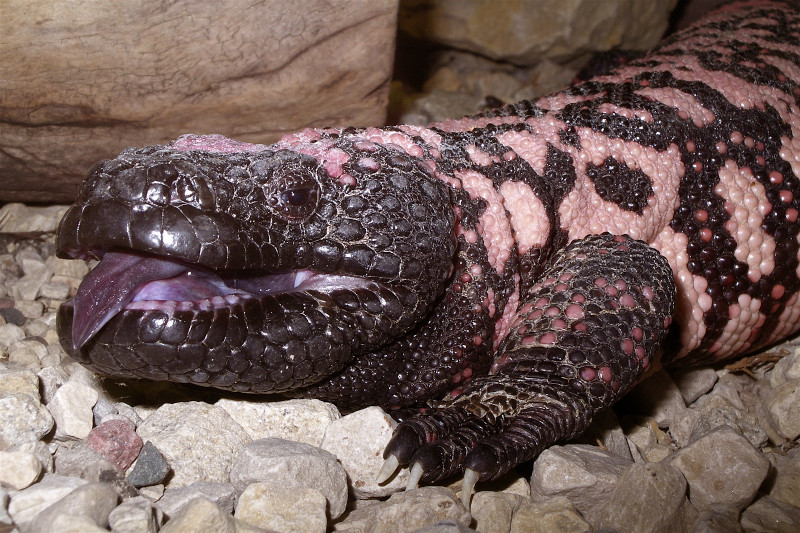
Gila Monster Facts
- This extraordinary product of reptilian evolution most frequently goes by the attention-grabbing common name of the Gila Monster. Intriguingly, it has no other broadly accepted general titles. Sadly, this daunting one has stuck with the animal.
- Within scientific circles, however, the marvel of Nature is perhaps better known by its technical designation. Like most such terms, though, that’s somewhat difficult for the layperson to pronounce. It bears the formal epithet of Heloderma suspectum.
- The much-maligned creature received that appellation due to the efforts of Edward Drinker Cope. This respected American herpetologist achieved the first recognition of it as a separate and distinct species. He managed that notable feat in 1869.
- It stands out in the minds of many because of its nature and location. That’s due to the fact that it represents the only venomous lizard native to its region. But, despite having a fearsome reputation, its slow-moving nature means its rarely dangerous to man.
- Unfortunately, however, the amazing Gila Monsters currently finds itself in dire straits. Its present population appears to be continuing to dwindle. This holds true even though it became a protected species in 1952. The IUCN lists it as Near Threatened.
- The wonder of evolution faces multiple threats to its continued existence as a species. Like most similar species, the majority of these stem from the actions of man. Its greatest threats consist of the dual dangers of habitat loss and ongoing climate change.
Related Articles
Gila Monster Physical Description
The fascinating Gila Monster typically draws a great deal of attention from those fortunate enough to view the reptile. Yet, it does so for more than just its reputation. That’s because this distinctive member of its Genus also achieves some respectable dimensions.
It also follows a pattern of development shared my many of its relatives around the world in this regard. That’s in the fact that it displays a certain amount of the physiological characeristic of sexual dimorphism. In its case, that trait manifests itself in unusual ways.
Males of this biological marvel generally display noticeably larger heads than their female counterparts. This gender also usually possesses a stouter body shape. Along with a narrower head, the females more commonly develop a more pear-shaped body structure.
Aside from these differences, though, the two sexes present the same outward appearance to the observer. The body attains an average length ranging from 10 – 14 in (26 – 36 cm). Yet, its tail varies in length, with the total ranging from roughly 20 – 22 in (51 – 56 cm).
The body mass of the Gila Monster also naturally varies. Notably, this occurs more due to the gender than individual variations. Typically, this runs from approximately 1.21 – 1.76 lbs (0.55 – 0. 8 kg). Though exceptional specimens do occur, they rarely exceed this by much.
It’s the coloring of the animal that perhaps most draws the eye, however. The background primarily consists of a covering of scales, showing a remarkable shade of light pink or orange. Augmenting this, though, is a pattern of random black bands and spots.
- Kingdom: Animalia
- Phylum: Chordata
- Class: Reptilia
- Order: Squamata
- Family: Helodermatidae
- Genus: Heloderma
- Species: H. suspectum
Gila Monster Distribution, Habitat, and Ecology
The marvelous Gila Monster evolved as native to only a moderate expanse of the surface of the earth. The nature and exact location of that zone of habitation might surprise many people, though. That’s true since it developed as indigenous to parts of North America.
Yet, even there it’s range remains limited. The distinctive lizard mainly lives within the northwest portions of the United States. There, it appears in Nevada, Utah, Arizona, New Mexico, and parts of California. A small population also dwell in Sonora, Mexico, however.
Nature further provided the amazing animal with a degree of adaptability to a moderately broad range of habitat types. It therefore resides in several different ecosystems. That high degree of flexibility gives the intrepid creature a distinct evolutionary advantage.
These areas of habitation principally consists of regions of either scrubland, oak woodlands, or cacti-filled desert areas. In each of these environments, it’s typically found in thickets, shallow burrows, and under larger rocks. They generally tend to avoid most open areas.
Due to the harsh nature of their surroundings, the Gila Monster evolved to spend the great majority of its time in shelters or underground. It’s most active during the spring and early summer in the mornings. The natural marvel also typically changes shelter every 4 – 5 days.
The reptile further evolved as mainly carnivorous in terms of its diet. This primarily consists of such fare as mice, rabbits, hares, small birds, snakes, frogs, insects, and even carrion. But, it also feeds on the eggs of lzards, birds, snakes, and tortoises when it finds them.
Nature also provided this species with yet other advantages. As mentioned previously, it’s also venomous. Unlike snakes, this isn’t injected via fangs. Instead, it bites firmly, breaking the skin, and releases the toxin from glands. It’s rarely fatal to healthy adult humans.
Species Sharing Its Range
Check out our other articles on 4 Marvelous Mammals of Madagascar, Cape Porcupine, Great Barrier Reef, Snake’s Head Fritillary, Southern Stingray, East African Lowland Honey Bee, Serval
